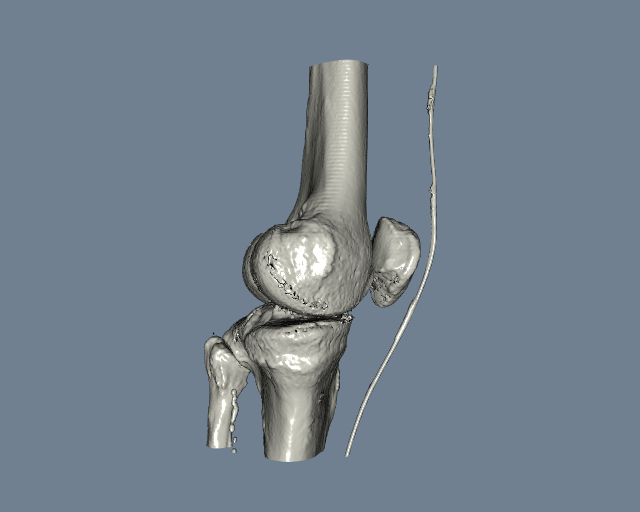ReadSLC
vtk-examples/Cxx/IO/ReadSLC
Description¶
In this example you will familiarize yourself with the stages required to read a .slc file and create a visualization pipeline in VTK. Following is the three step procedure:
-
Read the data from .slc file using vtkSLCReader
-
Implement Marching cubes Algorithm using vtkContourFilter
-
Create Visualization pipeline to visualize data using an actor, mapper and rendering window
Cite
This example was provided by Bharatesh Chakravarthi from Virtual Environment Lab, Chung-Ang University, Seoul, South Korea
Question
If you have a question about this example, please use the VTK Discourse Forum
Code¶
ReadSLC.cxx
#include <vtkActor.h>
#include <vtkCamera.h>
#include <vtkContourFilter.h>
#include <vtkExtractVOI.h>
#include <vtkNamedColors.h>
#include <vtkNew.h>
#include <vtkOutlineFilter.h>
#include <vtkPolyDataMapper.h>
#include <vtkProperty.h>
#include <vtkRenderWindow.h>
#include <vtkRenderWindowInteractor.h>
#include <vtkRenderer.h>
#include <vtkSLCReader.h>
// Author: Bharatesh Chakravarthi
// Affiliation: Virtual Environment Lab, Chung-Ang University, Seoul, South
// Korea
int main(int argc, char* argv[])
{
if (argc < 2)
{
// Pass the filename (<filename>.slc) as parameter to read .slc file
std::cout << "Required parameters: Filename(.slc) e.g vw_knee.slc"
<< std::endl;
return EXIT_FAILURE;
}
double isoValue = 72.0;
if (argc < 3)
{
isoValue = 72.0;
}
else
{
isoValue = std::atof(argv[2]);
}
std::string inputFilename = argv[1];
// Using vtkSLCReader to read Volumetric file format(<filename.slc>)
vtkNew<vtkSLCReader> reader;
reader->SetFileName(inputFilename.c_str());
reader->Update();
// Implementing Marching Cubes Algorithm to create the surface using
// vtkContourFilter object
vtkNew<vtkContourFilter> cFilter;
cFilter->SetInputConnection(reader->GetOutputPort());
// Change the range(2nd and 3rd Parameter) based on your
// requirement. recommended value for 1st parameter is above 1
// cFilter->GenerateValues(5, 80.0, 100.0);
cFilter->SetValue(0, isoValue);
cFilter->Update();
// Adding the outliner using vtkOutlineFilter object
vtkNew<vtkOutlineFilter> outliner;
outliner->SetInputConnection(reader->GetOutputPort());
outliner->Update();
// Visualize
vtkNew<vtkPolyDataMapper> mapper;
mapper->SetInputConnection(cFilter->GetOutputPort());
mapper->SetScalarVisibility(0);
vtkNew<vtkNamedColors> colors;
vtkNew<vtkActor> actor;
actor->SetMapper(mapper);
actor->GetProperty()->SetDiffuse(0.8);
actor->GetProperty()->SetDiffuseColor(colors->GetColor3d("Ivory").GetData());
actor->GetProperty()->SetSpecular(0.8);
actor->GetProperty()->SetSpecularPower(120.0);
// extractVOI is used to fix the problem of subsampling of data and reduce
// slow interaction and increase loading speed
vtkNew<vtkExtractVOI> extractVOI;
extractVOI->SetInputConnection(reader->GetOutputPort());
extractVOI->SetSampleRate(2, 2, 2);
extractVOI->Update();
vtkNew<vtkRenderer> renderer;
vtkNew<vtkRenderWindow> renderWindow;
renderWindow->AddRenderer(renderer);
renderWindow->SetSize(640, 512);
vtkNew<vtkRenderWindowInteractor> renderWindowInteractor;
renderWindowInteractor->SetRenderWindow(renderWindow);
renderer->AddActor(actor);
renderer->SetBackground(colors->GetColor3d("SlateGray").GetData());
renderWindow->Render();
// Pick a good view
vtkCamera* cam1 = renderer->GetActiveCamera();
cam1->SetFocalPoint(0.0, 0.0, 0.0);
cam1->SetPosition(0.0, -1.0, 0.0);
cam1->SetViewUp(0.0, 0.0, -1.0);
cam1->Azimuth(-90.0);
renderer->ResetCamera();
renderer->ResetCameraClippingRange();
renderWindow->SetWindowName("ReadSLC");
renderWindow->Render();
renderWindowInteractor->Start();
return EXIT_SUCCESS;
}
CMakeLists.txt¶
cmake_minimum_required(VERSION 3.12 FATAL_ERROR)
project(ReadSLC)
find_package(VTK COMPONENTS
CommonColor
CommonCore
FiltersCore
FiltersModeling
IOImage
ImagingCore
InteractionStyle
RenderingContextOpenGL2
RenderingCore
RenderingFreeType
RenderingGL2PSOpenGL2
RenderingOpenGL2
)
if (NOT VTK_FOUND)
message(FATAL_ERROR "ReadSLC: Unable to find the VTK build folder.")
endif()
# Prevent a "command line is too long" failure in Windows.
set(CMAKE_NINJA_FORCE_RESPONSE_FILE "ON" CACHE BOOL "Force Ninja to use response files.")
add_executable(ReadSLC MACOSX_BUNDLE ReadSLC.cxx )
target_link_libraries(ReadSLC PRIVATE ${VTK_LIBRARIES}
)
# vtk_module_autoinit is needed
vtk_module_autoinit(
TARGETS ReadSLC
MODULES ${VTK_LIBRARIES}
)
Download and Build ReadSLC¶
Click here to download ReadSLC and its CMakeLists.txt file. Once the tarball ReadSLC.tar has been downloaded and extracted,
cd ReadSLC/build
If VTK is installed:
cmake ..
If VTK is not installed but compiled on your system, you will need to specify the path to your VTK build:
cmake -DVTK_DIR:PATH=/home/me/vtk_build ..
Build the project:
make
and run it:
./ReadSLC
WINDOWS USERS
Be sure to add the VTK bin directory to your path. This will resolve the VTK dll's at run time.
